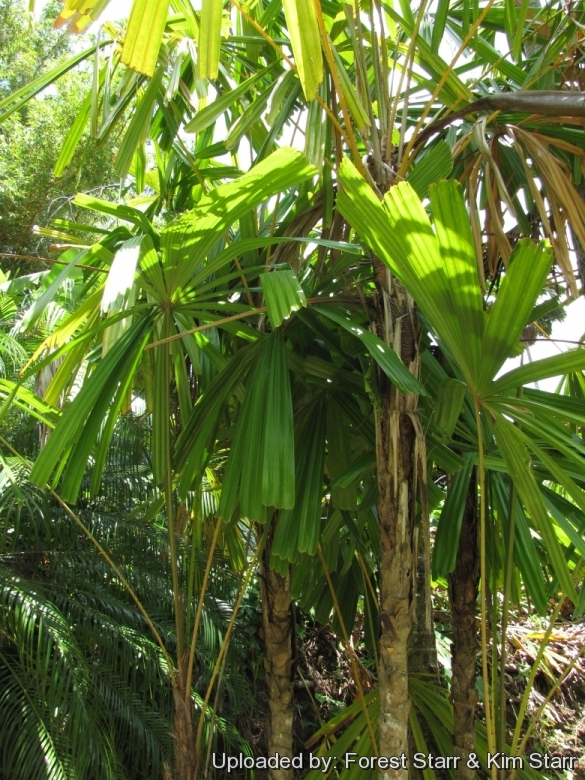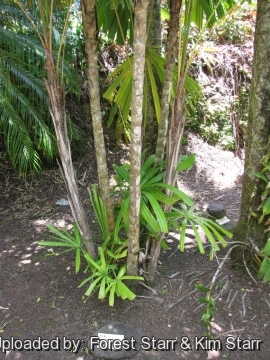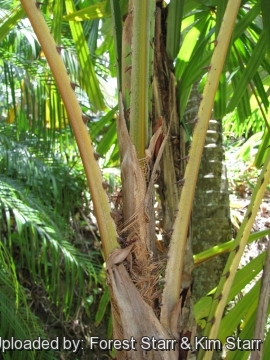




Your support is critical to our success.

Fronds Tropical Gardens of Maui, Maui, Hawaii (USA). May 22, 2012.
Origin and Habitat: Licuala spinosaSN|28514]]SN|28514]] is native to Andaman and Nicobar Islands (west of Indonesia), Thailand, Vietnam, Malaysia, the Philippines, Sumatra,Java, Borneo. Andaman Is., Cambodia, Hainan, Jawa, Malaya, Myanmar, Nicobar Is., and Sumatera, but now also growing in Suriname. However it is very well established in cultivation for its unique beauty throughout the tropics and subtropics as a specimen plant.
Habitat and ecology: It grows in moist, wet coastal areas, slightly swampy ground, lowland alluvial forest, river banks, peat and mangrove swamp forest, beach forest, primary forest. Water Loving Palm found in coastal areas.
Synonyms:
- Licuala spinosa Wurmb
Licuala spinosa Wurmb
Verh. Batav. Genootsch. Kunst. 2: 474 (1780)
Synonymy: 8
- Licuala spinosa Wurmb
- Corypha pilearia Lour.
- Licuala acutifida var. peninsularis Becc.
- Licuala horrida Blume
- Licuala pilearia (Lour.) Blume
- Licuala ramosa Blume
- Licuala spinosa var. cochinchinensis Becc.
- Licuala spinosa var. eriantha Becc.
ENGLISH: Mangrove fan palm, Spiny licuala, Spiny licuala palm, Good luck palm
CHINESE (中文): 刺轴榈
MALAY (بهاس ملاي /Bahasa Melayu ): Pokok Palas Duri
PERSIAN (فارسی): لیکوآلا اسپینوزا
Description: Licuala spinosa is a densely clumping palm of medium height, with slender stems and heads of circular, divided fan leaves. It is common in cultivation and may reach 3-4 m height. Known as the spiny Licuala because the leafstalk are savagely armed with many tiny, pointed spines.
Trunk: Multiple, suckering, slim, 3 to 4 (or more) m tall and about 23 mm across.
Crown: Dense (to 4 metres in diameter) of about 15 to 17 fan-shaped leaves.
Leaves (fronds): Peltate-orbicular, dark green, about 50-65 cm long, about 80-150 cm wide, segment about 14-19, all rather the same size with squared-off ends; central segment slightly larger than rest, splitted in two (half to 5-7 cm toward leaf base), sometimes petiolulate, with about 8-14 ribs, 52-65 cm long, 20-23 cm wide. Petioles to 2 m long, margins armed with black thorn, 10-20 mm near base, 5-10 mm toward apex, green to yellow brownish; spines along whole length of petiole, triangular largest near base. Sheaths disintegrating into coarse reticulate fibers with dark brown colours.
Inflorescences: Upright to pendulous from among the leaf bases, longer than leaves, extend above the crown, with 7-9 partial inflorescences, about 1.5-3 m long, branching to two orders.
Flowers: Solitary or in group of 2-4, sessile, densely arranged, cincinni 5-10 per cm, maturing not simultaneously; bud about 4-5 x 2.5-3 mm;
Fruit: Globose about 6.5-8.5 long, 6-8 mm in diameter, glabrous, smooth, immature fruit green and orange to red when mature.
Seed: Globose, smooth, about 4-6 mm across.
Bibliography: Major references and further lectures
1) Andrew Henderson “Palms of Southern Asia” Princeton University Press, 27/Apr/2009
2) Forest & Kim Starr Licuala spinosa (mangrove fan palm, spiny licuala). Plants of Hawaii. <http://www.starrenvironmental.com>. Downloaded on 31 August 2014.
3) John Dransfield, Natalie W. Uhl “Genera Palmarum: the evolution and classification of palms” Kew Pub., 2008
4) Uhl, N.W. & Dransfield, J.“Genera Palmarum. Lawrence.” Allen Press. 1987
5) Dransfield, J. 1976. “Palms in the every life of west Indonesia.” Principes 20: 39-47.
6) Dransfield, J. & Moore, H.E. 1982. “The Martian correlation two editions of Martius’ Historia Naturalis Palmarum Compared.” Kew Bull 37: 91-116.
7) Wikipedia contributors. "Licuala spinosa" Wikipedia, The Free Encyclopedia. Wikipedia, The Free Encyclopedia, Accessed on 28 Aug. 2014
8) Don Ellison, Anthony Ellison “Cultivated Palms Of The World” UNSW Press, 01/May/2001
9) Robert Lee Riffle, Paul Craft “An Encyclopedia of Cultivated Palms” Timber Press, Portland 2007
10) "Licuala spinosa." PACSOA Palms and Cycads wiki , <http://www.pacsoa.org.au> Accessed on 28 Aug. 2014
11) Palmpedia contributors. "Licuala spinosa." Palmpedia, PALM ENCYCLOPEDIA, <http://www.palmpedia.net> Downloaded on 26 Aug. 2014
12) Jones, D. L. “Palms throughout the world.” 1994
13) John Leslie Dowe “Australian Palms: Biogeography, Ecology and Systematics” Csiro Publishing, 2010
14) Fred Donald Rauch, Paul R. Weissich “Plants for Tropical Landscapes: A Gardener's Guide” University of Hawaii Press, 2000

Habit with sign at Iao Tropical Gardens of Maui, Maui, Hawaii (USA). May 22, 2012. Photo by: Forest Starr & Kim Starr

Armed petioles at Iao Tropical Gardens of Maui, Maui, Hawaii (USA). May 22, 2012. Photo by: Forest Starr & Kim Starr
Cultivation and Propagation: Licuala spinosaSN|28514]]SN|28514]] is an excellent relatively fast-growing garden plant adapt to different climates, from tropical to warm temperate. It prefers full sun, a lot of water, and is more cold hardy than most Licuala species. It lives well under average home conditions in bright light with moderate maintenance.
Soil requirements: It does best in wet soils such as pond edges and streams, even close to brackish water. However it is adaptable and can even thrives in poor soils, but do better when grown in nutrient-rich soils with regular watering.
Watering: It prefers moist soils (also saturated), and is usually very happy in poorly drained areas. One precaution you could use to make this palm look nice is misting the leaves during hottest summer days. This palm is sensitive to salts and minerals, so if your home uses a water softener, use water from a source that does not go through the softener first, such as an outside faucet. As most tropical plants, an occasional misting will make your Palm look and feel healthier.
Light: It adapts well to full sun or part shade, but looks its best in bright light (indoors or out). If home-grown, give some sun as with most tropical palms.
Fertilization: Need a perfect fertilizer diet including all micro nutrients and trace elements.
Aerosol salt tolerance: It is moderately salt tolerant, but does a lot better inland then it does on the coast.
Hardiness: They grow well in tropical and subtropical climates but will also grow in particular favourable Mediterranean frost free microclimates. (USDA hardiness zones 9b-11), and mature, established specimens can tolerate temperatures down to -5 °C, but only for a few hours; normal temperatures should not go below 10°. (USDA Zones 9B – 11)
Wind hardiness: It cannot tolerate sweltering heat and windy conditions. Protection from strong winds prevents leaf damage.
Maintenance: Remove dried fronds.
Use: It is grown as an ornamental plant in gardens in tropical and subtropical regions, and elsewhere indoors. Use as a hedge, screen, or barrier planting.
Traditional uses: Ornamentals, and decorations, roofing, food-wrappers, walking sticks, binding, making hats, and eaten as vegetables. Sprays of its orange fruit and large leaves are used in arrangements. The leaves of Licuala spinosaSN|28514]]SN|28514]] and of Borassus flabelliformis were used on the coast of Asia and in Ceylon instead of paper.
Disease & Pests: It is quite resistant to pests but may require regular fertilization to prevent yellowing caused by potassium deficiencies; protect against scale insects, frost and spider mites.
Propagation: Fresh seeds germinate within 2-6 months of being planted and the seedlings are attractive. If not properly treated, the seed does not have long shelf life. It produces offsets, and these can be cut off, when mature enough, as a propagation method. For propagation select sturdy, shapely, healthy plant free from insect and disease damage. New leaf growth is desirable.
| Your Actions | |
|---|---|
| Back to Licuala index | |
| Back to Arecaceae index | |
 |
Back to Palms And Cycads Encyclopedia index |
Privacy stantement - Terms and conditions - How to cite - About us - Feedback - Donate


